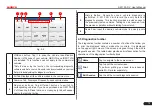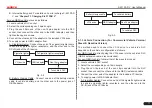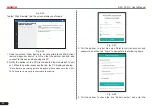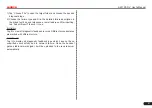
26
LAUNCH
X-431 PAD V
User's Manual
*Note: Retrieving and using DTCs for troubleshooting vehicle operation
is only one part of an overall diagnostic strategy. Never replace a part
based only on the DTC definition. Each DTC has a set of testing procedures,
instructions and flow charts that must be followed to confirm the location
of the problem. This information can be found in the vehicle’s service
manual.
On-screen Buttons:
Freeze Frame: When an emission-related fault occurs, certain vehicle
conditions are recorded by the on-board computer. This information
is referred to as freeze frame data. Freeze frame data includes a
snapshot of critical parameter values at the time the DTC is set.
Help: Tap to view the help information.
Code Search: Tap it to search for more information about the current
DTC online.
Report: To save the current data in text format. All diagnostic reports
can be accessed from “User Info” -> “My Reports” -> “Diagnostic
Report”.
C. Clear Fault Code
After reading the retrieved codes from the vehicle and certain repairs
have been carried out, you can use this function to erase the codes
from the vehicle. Before performing this function, please be sure the
vehicle’s ignition key is in the ON position with the engine off.
Clearing DTCs does not fix the problem(s) that caused the code(s) to
be set. If proper repairs to correct the problem that caused the code(s)
to be set are not made, the code(s) will appear again and the check
engine light will illuminate as soon as the problem that cause the DTC
to set manifests itself.
In Fig. 5-25, tap “Clear Fault Code”, a confirmation dialog box pops up
on the screen. Tap “Yes” and the system will automatically delete the
currently existing trouble code.
*Note: After clearing, you should retrieve trouble codes once more or turn
ignition on and retrieve codes again.
If there are still some trouble codes in
the system, please troubleshoot the code using a factory diagnosis guide,
then clear the code and recheck.
D. Read Data Stream
This option lets you view and capture (record) real-time Live Data.
This data including current operating status for parameters and/or
sensor information can provide insight on overall vehicle performance.
It can also be used to guide vehicle repair.
*Note: If you must drive the vehicle in order to perform a troubleshooting
procedure, ALWAYS have a second person help you.
Trying to drive and
operate the diagnostic tool at the same time is dangerous, and could cause
a serious traffic accident.
In Fig. 5-25, tap “Read Data Stream”, the system will display data
stream items.
Fig. 5-28






























